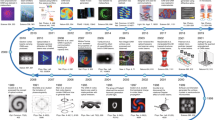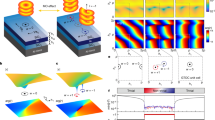Abstract
The exploration of physical degrees of freedom of light with infinite dimensionality, such as orbital angular momentum (OAM) and frequency, has profoundly reshaped the landscape of modern optics, with representative photonic functional devices including optical vortex emitters and frequency combs. In nanophotonics, whispering gallery mode microresonators naturally support applications based on the OAM of light and have been employed as on-chip emitters of monochromatic optical vortices. On the other hand, whispering gallery mode microresonators can serve as a highly efficient non-linear optical platform for producing light at different frequencies, that is, microcombs. Here we combine optical vortices and microcombs by demonstrating an optical vortex comb on a III–V integrated non-linear ring microresonator. The angular grating-dressed non-linear microring simultaneously emits spatiotemporal light springs consisting of 50 OAM modes, with each frequency of the microcomb carrying a distinct OAM value. We also experimentally generate optical pulses with time-varying OAM by carefully endowing the spatiotemporal light springs with a specific intermodal phase relation. We expect our work to favour the development of integrated non-linear and quantum photonics for exploring fundamental optical physics and advancing photonic quantum technology.
This is a preview of subscription content, access via your institution
Access options
Access Nature and 54 other Nature Portfolio journals
Get Nature+, our best-value online-access subscription
$29.99 / 30 days
cancel any time
Subscribe to this journal
Receive 12 print issues and online access
$209.00 per year
only $17.42 per issue
Buy this article
- Purchase on Springer Link
- Instant access to full article PDF
Prices may be subject to local taxes which are calculated during checkout




Similar content being viewed by others
Data availability
The data that support the plots within this paper and other findings of this study are available via figshare at https://doi.org/10.6084/m9.figshare.24771078 (ref. 39). All other data used in this study are available from the corresponding authors on reasonable request.
References
Allen, L., Beijersbergen, M. W., Spreeuw, R. J. C. & Woerdman, J. P. Orbital angular momentum of light and the transformation of Laguerre–Gaussian laser modes. Phys. Rev. A 45, 8185–8189 (1992).
He, C., Shen, Y. & Forbes, A. Towards higher-dimensional structured light. Light Sci. Appl. 11, 1–17 (2022).
Wang, J. et al. Terabit free-space data transmission employing orbital angular momentum multiplexing. Nat. Photon. 6, 488–496 (2012).
Erhard, M., Fickler, R., Krenn, M. & Zeilinger, A. Twisted photons: new quantum perspectives in high dimensions. Light Sci. Appl. 7, 17146 (2018).
Cai, X. et al. Integrated compact optical vortex beam emitters. Science 338, 363–366 (2012).
Ren, H. et al. Metasurface orbital angular momentum holography. Nat. Commun. 10, 1–8 (2019).
Sroor, H. et al. High-purity orbital angular momentum states from a visible metasurface laser. Nat. Photon. 14, 498–503 (2020).
Zhou, N. et al. Ultra-compact broadband polarization diversity orbital angular momentum generator with 3.6 × 3.6 μm2 footprint. Sci. Adv. 5, eaau9593 (2019).
Chen, B. et al. Bright solid-state sources for single photons with orbital angular momentum. Nat. Nanotechnol. 16, 302–307 (2021).
Ma, Y. et al. On-chip spin-orbit locking of quantum emitters in 2D materials for chiral emission. Optica 9, 953–958 (2022).
Miao, P. et al. Orbital angular momentum microlaser. Science 353, 464–467 (2016).
Hayenga, W. E. et al. Direct generation of tunable orbital angular momentum beams in microring lasers with broadband exceptional points. ACS Photonics 6, 1895–1901 (2019).
Zhang, Z. et al. Tunable topological charge vortex microlaser. Science 368, 760–763 (2020).
Chang, L., Liu, S. & Bowers, J. E. Integrated optical frequency comb technologies. Nat. Photon. 16, 95–108 (2022).
Gaeta, A. L., Lipson, M. & Kippenberg, T. J. Photonic-chip-based frequency combs. Nat. Photon. 13, 158–169 (2019).
Pfeiffer, M. H. et al. Ultra-smooth silicon nitride waveguides based on the damascene reflow process: fabrication and loss origins. Optica 5, 884–892 (2018).
Puckett, M. W. et al. 422 million intrinsic quality factor planar integrated all-waveguide resonator with sub-MHz linewidth. Nat. Commun. 12, 1–8 (2021).
Pu, M., Ottaviano, L., Semenova, E. & Yvind, K. Efficient frequency comb generation in AlGaAs-on-insulator. Optica 3, 823–826 (2016).
Chang, L. et al. Ultra-efficient frequency comb generation in AlGaAs-on-insulator microresonators. Nat. Commun. 11, 1331 (2020).
Shen, Y. et al. Roadmap on spatiotemporal light fields. J. Opt. 25, 093001 (2023).
Zhao, Z. et al. Dynamic spatiotemporal beams that combine two independent and controllable orbital-angular-momenta using multiple optical-frequency-comb lines. Nat. Commun. 11, 1–10 (2020).
Chong, A., Wan, C., Chen, J. & Zhan, Q. Generation of spatiotemporal optical vortices with controllable transverse orbital angular momentum. Nat. Photon. 14, 350–354 (2020).
Wan, C., Cao, Q., Chen, J., Chong, A. & Zhan, Q. Toroidal vortices of light. Nat. Photon. 16, 519–522 (2022).
Zdagkas, A. et al. Observation of toroidal pulses of light. Nat. Photon. 16, 523–528 (2022).
Chen, L. et al. Synthesizing ultrafast optical pulses with arbitrary spatiotemporal control. Sci. Adv. 8, eabq8314 (2022).
Rego, L. et al. Generation of extreme-ultraviolet beams with time-varying orbital angular momentum. Science 364, eaaw9486 (2019).
Lu, X. et al. Highly-twisted states of light from a high quality factor photonic crystal ring. Nat. Commun. 14, 1119 (2023).
Pariente, G. & Quéré, F. Spatio-temporal light springs: extended encoding of orbital angular momentum in ultrashort pulses. Opt. Lett. 40, 2037–2040 (2015).
Béjot, P. & Kibler, B. Spatiotemporal helicon wavepackets. ACS Photonics 8, 2345–2354 (2021).
Piccardo, M. et al. Broadband control of topological-spectral correlations in space-time beams. Nat. Photon. 17, 822–828 (2023).
Rañada, A. F. & Vázquez, L. On the self-torque on an extended classical charged particle. J. Phys. A 17, 2011 (1984).
Dolan, S. R. et al. Gravitational self-torque and spin precession in compact binaries. Phys. Rev. D 89, 064011 (2014).
Helgason, Ó. B. et al. Surpassing the nonlinear conversion efficiency of soliton microcombs. Nat. Photon. 17, 992–999 (2023).
Dada, A. C. et al. Experimental high-dimensional two-photon entanglement and violations of generalized Bell inequalities. Nat. Phys. 7, 677–680 (2011).
Hu, X. M. et al. High-dimensional Bell test without detection loophole. Phys. Rev. Lett. 129, 060402 (2022).
Liu, J. et al. Emerging material platforms for integrated microcavity photonics. Sci. China Phys. Mech. Astron. 65, 104201 (2022).
Li, H., Bazarov, I. V., Dunham, B. M. & Wise, F. W. Three-dimensional laser pulse intensity diagnostic for photoinjectors. Phys. Rev. ST Accel. Beams 14, 112802 (2011).
Zhu, J. et al. Spin and orbital angular momentum and their conversion in cylindrical vector vortices. Opt. Lett. 39, 4435–4438 (2014).
Chen, B. et al. Integrated optical vortex microcomb. figshare https://doi.org/10.6084/m9.figshare.24771078 (2024).
Acknowledgements
This research is supported by the National Key R&D Program of China (2021YFA1400800), VILLUM FONDEN (VIL50469), European Research Council (REFOCUS 853522), the National Natural Science Foundation of China (62035017, 12361141824, 12334017, 12293052, 12104522, 92050202, 61975243 and 12104309), the Natural Science Foundation of Guangdong (2022A1515011400), Guangdong Introducing Innovative and Entrepreneurial Teams of ‘The Pearl River Talent Recruitment Program’ (2021ZT09X044), the Danish National Research Foundation, SPOC (DNRF123), NanoPhoton (DNRF147), European Union’s Horizon 2020 Research and Innovation Programme under the Marie Sklodowska-Curie Grant Agreement (861097), the Guangdong Special Support Program (2019JC05X397), the Shanghai Science and Technology Committee (19060502500) and the Shanghai Sailing Program (21YF1431500). We thank Y. Chen, J. Liu and S. Yu for loaning equipment.
Author information
Authors and Affiliations
Contributions
J. Liu conceived the project. B.C., Y. Zhou and Q.C. performed the numerical simulations. Y. Zhou, C.Y. and Y.L. fabricated the devices. B.C., P.H., Jin Li, Y.L., C.Y., Jiaqi Li, Y. Zhang and Y. Zhou built the setup and characterized the devices. B.C., P.H., Y.L., C.Y., Y. Zhou, C.K., Y. Zheng, Q.C., Q.Z., M.P. and J. Liu analysed the data. M.P. and J. Liu wrote the paper with inputs from all authors. C.D., L.K.O., K.Y., Q.Z., X.W., M.P. and J. Liu supervised the project.
Corresponding authors
Ethics declarations
Competing interests
The authors declare no competing interests.
Peer review
Peer review information
Nature Photonics thanks the anonymous reviewers for their contribution to the peer review of this work.
Additional information
Publisher’s note Springer Nature remains neutral with regard to jurisdictional claims in published maps and institutional affiliations.
Extended data
Extended Data Fig. 1 Noise characterizations for microcomb states.
(a, b) show the representative microcomb spectra in a noisy state (a) and a soliton state (b). (c, d) show the corresponding RF spectra for different comb states (red). The blue traces show the reference traces recorded with no comb being generated. The increased power below 1 GHz (the red trace in (c)) suggests a noisy comb state.
Extended Data Fig. 2 Mode decomposition of the vortex microcomb.
(a) Schematic of the experimental setup for the OAM mode purity measurement. OL: the objective lens, BFP: the back focal plane, HWP: half-wave plate, P: polarizer, SLM: spatial light modulator, M: mirror, L1 - L2: lenses, CCD: charge-coupled device. (b, e) Measured on-axis intensity distributions for the linearly polarized component of the emitted superposition mode with l = 4 and l = -4. (c, f) Phase distributions applied to the SLM. (d, g) Measured far-field patterns for the linearly polarized component of the superposition mode. (h) OAM spectrum for frequency OAM modes from l = -5 to l = 9.
Extended Data Fig. 3 Simulation of the self-torque pules with the different CW/CCW compositions.
(a-e) Simulations for the single-helices self-torque pulses. (f-j) Simulations for the double-helices pulses. (c) and (h) are the results presented in Fig. 4 which employes the values extracted from the mode decomposition measurement in 2.
Supplementary information
Supplementary Information
Supplementary Figs. 1–10 and Discussion.
Rights and permissions
Springer Nature or its licensor (e.g. a society or other partner) holds exclusive rights to this article under a publishing agreement with the author(s) or other rightsholder(s); author self-archiving of the accepted manuscript version of this article is solely governed by the terms of such publishing agreement and applicable law.
About this article
Cite this article
Chen, B., Zhou, Y., Liu, Y. et al. Integrated optical vortex microcomb. Nat. Photon. (2024). https://doi.org/10.1038/s41566-024-01415-0
Received:
Accepted:
Published:
DOI: https://doi.org/10.1038/s41566-024-01415-0



